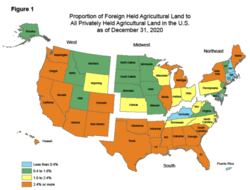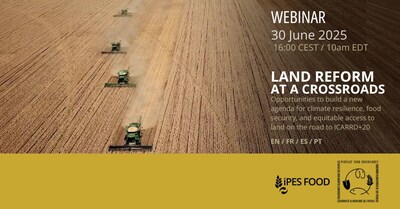
This USDA graphic shows the proportion of foreign-held agriculture land to all privately held agriculture land. Graphic is on page 10 of the PDF of USDA's 2020 AFIDA report.
Foreign investment in U.S. cropland nearly tripled in past decade, USDA data shows
By Johnathan Hettinger
Foreign investment in U.S. cropland has nearly tripled in the past decade, according to U.S. Department of Agriculture data.
The total cropland controlled by foreign interests in 2020 was 10.9 million acres, up from 4.1 million acres in 2010.
This increase has been largely driven by foreign-owned wind companies signing long-term leases on a large number of acres, according to the USDA. However, “the acres actually utilized by said companies are very few due to the small footprint of the wind towers erected on the land,” a USDA report said.
Foreign investors own more than just cropland. Overall, they own or lease nearly 37.6 million acres of agricultural land, including forests and pastures. That is an area slightly larger than the state of Illinois and makes up 2.9% of all privately held agricultural land in the U.S.
This is up from a total of 24.2 million acres in 2010, according to the USDA.
Under the Agricultural Foreign Investment Disclosure Act, all foreign holders of agricultural land — whether that is owners or long-term renters — must report those holdings to USDA.
Those reports are filed via a FSA-153 report. Each year, the USDA releases that information in an annual report, which shows where that investment is growing.
Investigate Midwest obtained a database containing all of the information behind the USDA’s report. Although the USDA has released a 2020 report, the latest data available is through 2019.
The database has significant gaps. There are more than 3.1 million acres without an owner listed. Spot checks show that many parcels listed are no longer controlled by the owner in the database. It is unclear if land is removed from the database after it is sold or a lease is terminated.
While the database has significant errors and often has incomplete information, it still is a strong indicator of the quantity of land being sold or leased to foreign interests.
This growing level of investment has sparked legislative action. Currently, three bills before Congress would require additional review of foreign investment. Also, 14 states restrict or prohibit foreign ownership of farmland, though none outright forbid it, according to a November memo by the Congressional Research Service.
U.S. Sen. Chuck Grassley, R-Iowa, has been one of the leading voices concerned about foreign ownership of agricultural land. As a representative, Grassley helped write AFIDA, which became law in 1978, and has introduced the bipartisan Food Security is National Security Act during multiple sessions of Congress.
Grassley said that America’s young farmers will struggle to replace an aging farming population if farmland continues to become an investment.
“If deep-pocketed investors come in, foreign or not, it drives up prices and makes it harder for new and beginning farmers to get started,” Grassley said in a Q-and-A posted on his website.
For years, Joe Maxwell has lobbied for more states to enact laws to monitor foreign investment in farmland. The president and cofounder of Farm Action, an advocacy group trying to counteract what it sees as an agricultural system that prioritizes corporations, he said AFIDA disclosures are unreliable.
“We have no confidence at the federal level that the law is working,” said Maxwell, a Democrat who formerly served as lieutenant governor of Missouri.
Maxwell said foreign investment, corporate investment and investment by billionaires concerns him the most. He contends these entities aren’t looking at the production value of farmland. They view it as an investment, he said, which in turn drives up prices for farmers.
“We want everyone to think about, ‘Who do you want to be your farmer?'” Maxwell said. “If you’re happy with Bayer/Monsanto — a German corporation — being your farmer. Or Saudi Arabia. Or China. Then OK. But if you’re not OK with that, then you ought to care about this issue. We ought to make sure the next generation of farmers are individuals who will care for the land for future generations and care about producing safe and healthy food for their neighbors.”
Institutional investors, such as TIAA-CREF, have been increasingly investing in U.S. agricultural land.
Many of the largest agricultural companies in the U.S. are foreign-owned.
JBS, a Brazilian company, and Smithfield, owned by Chinese company WH Group, are two of the largest meat companies in the U.S. Bayer and BASF, two German companies, and Syngenta, owned by the state-owned Chinese chemical company, are also leading producers of seeds and agrochemicals.
According to the USDA’s database, Bayer, which bought Monsanto in 2018, owns at least 17,315 acres across 22 states and Puerto Rico. Syngenta owns at least 3,558 acres across 14 states.
But the true figures may be higher. It can be difficult to track the exact number of acres owned by a corporation because of the number of holding companies with different names that many corporations have.
The largest holders of U.S. agriculture land are based in Canada (12.3 million acres), the Netherlands (4.9 million acres) and Italy (2.7 million acres). The single largest corporations that control U.S. agricultural land are generally institutional investors of timberland. Foreign renewable energy companies are also increasing their level of investment.
Foreign investment in agricultural land is split into five categories: forest, pasture, cropland, other ag and non-ag. The largest category for foreign ownership is forest land.
That is particularly true in the state of Maine, where 19.5% of agricultural land is controlled by foreign investors. This is largely due to foreign institutional investment in companies that own timberland.
In Hawaii, 9.2% of agricultural land (totalling 171,108 acres) is controlled by foreign investors. Of that, 42.6% is controlled by Japanese companies, while 27.3% is controlled by New Zealand investors, as of 2019.
The figures for Midwestern states are considerably smaller. For instance, foreign investors control 2.6% of agricultural land in Illinois and 1.6% in Iowa.
In recent years, there has been a trend of foreign-owned energy companies leasing large swaths of land, fueled by federal tax credits.
Generally, when a wind turbine is on U.S. cropland, most of the acreage remains in production, surrounding a small area offset for the turbine structure and maintenance of the turbine.












